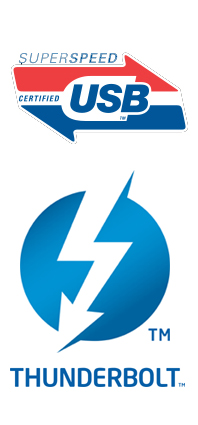Thunderbolt Flash Drives – Myth or Reality
Back in February Intel announced a new High Speed technology called Thunderbolt™. Thunderbolt supports data transfer speeds of up to 10GB per second, which means you could transfer a full-length HD movie between two devices running Thunderbolt in around 30 seconds!
Although Intel announced its Thunderbolt was a joint development with Apple so its no surprise that most of the new products launched by Apple since the announcement have included Thunderbolt. (new iMac, new Macbook Air, new Macbook Pro).
Considering that USB 3.0 is only just beginning to reach the market the announcement of Thunderbolt took many by surprise and raised doubts over what will emerge as the dominant standard for peripherals and data transfer – the thought of another VHS Vs Betamax tussle is not something the industry needs just now.
Whilst USB 3.0 products are backwards compatible with USB 2.0, Thunderbolt is completely different; different cables, different connectors and completely different protocol, so USB products, including USB flash drives will not work with Thunderbolt.
Here are a few basic facts to consider about Thunderbolt:
- Thunderbolt I/O technology gives you two channels on the same connector with 10 Gbps of throughput in both directions.
- Thunderbolt transfers data up to 20 times faster than with USB 2.0, up to 12 times faster than with FireWire 800 and twice as fast as USB 3.0
- A range of Thunderbolt storage peripherals are already available including storage products from Lacie (Lacie’s Little Big Disk)
Talk in the market is that Intel has so far failed to build support for USB 3.0 into any of its motherboard chipsets. If this is the case just where does this leave USB 3.0 and are we on the verge of seeing portable storage drives that use Thunderbolt technology?
To confuse matters further HP (the worlds largest producer of PC’s) has announced that it is sticking with USB 3.0 because it has wider support in the market. They’re not saying “no” to Thunderbolt just yet but instead they seem to be keeping a “watching brief” on it.
With the amount of influence Apple and Intel carry in the PC and tablet market at the moment you have to assume that at some stage a Thunderbolt Flash Drive is going to appear. Exactly when and at what cost is anyone’s guess but for now most people seem content with their standard USB 2.0 flash drives.

